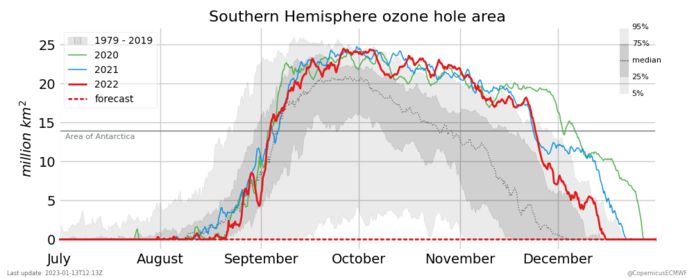The ozone layer plays an important role in blocking harmful UV rays from the sun. For a long time, the ban on CFCs seemed to shrink the ozone hole. But still Recent findings Scientists have suggested that the ozone layer may never recover from New Zealand. Indeed, in the last three years (2020-2022), large and long-lasting holes in the ozone layer above Antarctica have reappeared. Factors such as forest fires, volcanic eruptions and greenhouse gas emissions may be responsible for this.
The ozone layer is located between 11 and 40 kilometers above the Earth's surface. This layer acts as a filter for most of the sun's UV rays, which can cause skin cancer. Since the 1970s, chemicals (CFCs) have been depleting the ozone layer, resulting in large annual gaps. These were mainly located above Antarctica. The 1987 Montreal Protocol banned these CFCs. With this international environmental cooperation in place, recovery of the ozone layer above Antarctica is predicted by 2066.
Despite the decline in CFCs, New Zealand researchers now report no significant reduction in the Antarctic ozone hole in a new study in Nature Communications. They say the center of the hole shows ozone depletion over time. Six of the last nine years have been characterized by low ozone levels and large ozone holes.
Read more below the image

Atmospheric changes, likely due to climate change, are masking some of the recovery, scientists report. But they did not explore this in detail. A combination of wildfires, volcanic aerosols and greenhouse gas emissions explain recent setbacks, with record ozone holes reappearing in Antarctica starting in the spring of 2020. Hannah Kesenich, lead author of the study, asserts The Montreal Protocol and CFC reductions are still on track. But their findings show that other factors may be contributing to recent ozone problems.
However, scientist Martin Zucker attaches little credence to the study's results. He points out The results rely heavily on large ozone holes in 2020-2022. Existing literature finds explanations for the large ozone holes, such as the 2019 wildfires, volcanic eruptions, and the relationship between the polar stratosphere and a rare triple La Niña in 2020-2022. In addition, the analysis ignored data from 2002 and 2019, when smaller ozone holes formed due to the polar vortex disruption.
Read more below the image

Previous studies have shown that the ozone hole increased by 10 percent in 2020 due to widespread bushfires on 'Black Saturday' in Australia. The 2022 eruption of the Hunga-Tonga-Hunga-Ha'pai volcano in Tonga is thought to have affected recent ozone levels. “It is not clear why the authors chose to exclude the data from 2002 and 2019 from the study, but not the 2020-2022 data, all of which are years affected by very special and rare events,” Zucker said.
“Ozone Gas Leads to Health Problems”: Why We Can't Do Without Ozone and It Still Impacts Our Health (+)
The hole in the ozone layer begins to form exceptionally early this year: “It's already 16 million square kilometers”
'Polar vortex' turns over North Pole: What is it? What are the consequences? Will there be more severe winters? Expert explains (+)
Is Unlimited Access to Showbytes Free? What can!
Log in or create an account and never miss a thing from the stars.

“Introvert. Communicator. Tv fanatic. Typical coffee advocate. Proud music maven. Infuriatingly humble student.”











More Stories
Russian Tortoises: The Ideal Pet for Reptile Enthusiasts
Biden and Xi want to sit down one last time
The United States won gold in the team relay on the opening day of the mountain bike world championships